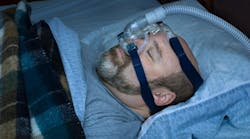A study of thousands of truck drivers who were given free CPAP machines to treat sleep apnea saved the company an estimated $441 per month, per driver in medical insurance costs from health care problems other than sleep apnea.
The findings indicate the savings could be even higher if other factors were taken into consideration, lead author Stephen Burks, professor of economics and management at the University of Minnesota-Morris, told Fleet Owner. "We didn't have the data to look at other savings such as lost workdays, medications, injury costs and crash costs. The last one could be particularly significant."
Untreated sleep apnea is associated with many adverse health conditions, including cardiovascular events in males, systemic hypertension and pulmonary hypertension, depression, insomnia, Type II Diabetes, obesity, and mortality.
"Accordingly, untreated OSA (obstructive sleep apnea) has been implicated in higher healthcare utilization and higher healthcare costs," the report stated.
The study looked at medical records of drivers from truckload carrier Schneider National who received free sleep apnea diagnoses and treatment. The program began in 2006, and most testing now is done at home or in sleeper bunks. Schneider officials could not be reached for comment, but the company website notes that a 2016 study (also conducted by Burks and his team) showed "the rate of serious, preventable crashes was five times higher among truck drivers with OSA who did not adhere to Schneider’s sleep apnea treatment program, compared with matched controls."
Like many large carriers, Schneider is self-insured, so savings accrue directly to the bottom line. Smaller carriers can benefit, too, the report stated.
"Medical insurance providers to smaller carriers may expect similar benefits to those of the study firm, if they organize and manage an OSA program for their trucking firm customers that is similar to that of the study firm. The evidence presented suggests that medical insurance firms might lower their net costs by offering such customers an OSA program for their driver employees with screening, diagnosis, and treatment as preventive care at low or no charge, as long as the motor carrier makes the program mandatory (which is separately justifiable on safety grounds)," according to the report.
One limitation of the study, said Burks, is that some high medical-cost drivers were not included. The study noted: “medical and safety selection differentially removed high-cost drivers before they could enter the study and is likely to have especially affected drivers with serious OSA and/or serious complications."
Burks said the potential effect of including these drivers cannot be determined, although it is likely that their inclusion might lead to greater savings. The research also emphasized the $441 per month savings is a snapshot in time, and as drivers with sleep apnea age, their medical conditions might worsen. That could result in even greater savings.
From 1976-86, Burks worked as truck driver, which he said stoked his passion for research into the health of drivers.
"My commitment comes from being on the road," he said.
When asked what would happen if all carriers were required to institute mandatory sleep testing and free CPAP equipment, he said: "It would help stop resistance to standard OSA screening. From a regulatory view, I don't see this happening, but if it did it would level the playing field for drivers and carriers, and that would be better for the industry."
The report concluded: "Trucking firm managers and their medical insurance providers should consider these findings on cost savings, along with earlier findings on the reduction in the risk of serious preventable truck crashes, when considering OSA programs. Trucking safety regulators should consider them with respect to mandating OSA screening standards for commercial motor vehicle operators."
The study was published in the peer-reviewed journal Sleep.




